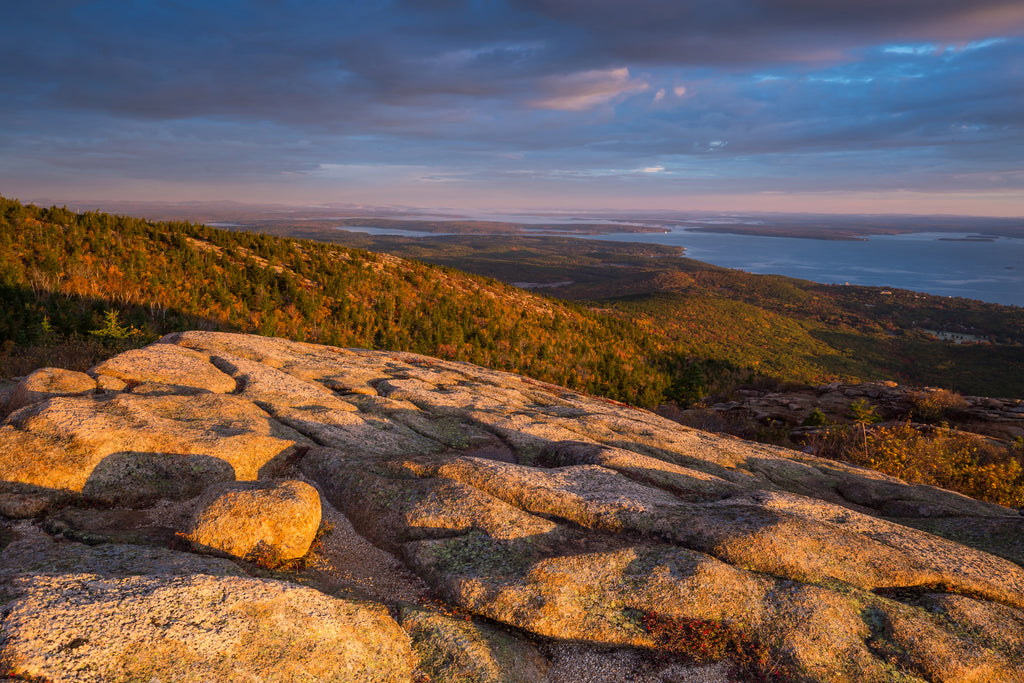An Atlantic Daydream at Acadia (by Mike Baker)
This year marks the 100th anniversary of Acadia National Park—originally named Lafayette National Park—America's 12th national park and the first east of the Mississippi River. The park's 420 million year-old location, Mount Desert Island, was first discovered by French explorer Samuel de Champlain in 1604, whose description of its bare granite mountains stuck for centuries. Eventually, the island’s pristine beauty attracted the attention of the burgeoning wealthy elite of 19th Century New England, who built lavish summer homes amid its "fjard", moraine, and glacial erratic geology.
Two such elite were John D. Rockefeller, Jr. and George Dorr, whose love for the island's beauty compelled them to give land, money, and tireless effort to preserve the region's innate ruggedness. Today, their legacy lives on in the park. "Rockefeller's Teeth" — the rocks that line the 45 miles of broken-stone Carriage Roads—can be seen throughout as one hikes and bikes (no cars allowed!) over the 16 stone bridges that support them. The Dorr Mountain is named after George Dorr, whose ashes were scattered over the park to honor his passing and service.

After passing the Cadillac Mountain entrance, the 27-mile Park Loop Road’s one-way direction places drivers on one of the most scenic roadways of all National Parks, providing a panoramic display of ponds, lakes, mountains, sea, forest, wetlands, streams, and wildflowers. An autumn hike on the Great Meadow Loop trail — just two miles of the park’s 158 miles of trails — near the Sieur de Monts spring puts Acadia’s full colors on display during what locals refer to as Leaf Peeping Season (May is considered a preferable time to visit the park as well). A series of hiking trails beneath Dorr Mountain circles The Tarn, a man-made lake originally dammed by George Dorr. In the winter, The Tarn features snow-covered rocks at its terminal end which locals refer to as "snow turtles."

This drive has something for everybody. Even if you don't spy beavers building their digs at Beaver Dam Pond, you (or your adrenaline-junkie friends) can opt to ascend Champlain Mountain down the road via the precarious Precipice Trail or the nearby Beehive Trail using metal rung handholds built into the rock. The Park Loop Road hugs the coastline, passing classic sites such as Old Soaker (a granite rock ledge in the middle of Newport Cove) and Thunder Hole (a naturally carved inlet that offers an up-close view of water crashing against the rocks producing 40'-high spouts!). The road winds around the iconic Otter Cliff coastline and passes by Blackwoods Campground, which, if you can stay for the night, is an incredible space to see moonlit views of the Atlantic.

Little Hunters Beach along the southern coast is a great example of the craggy shoreline's beauty. One tradition of Acadia is its prolific rock cairns. The twin-column & lintel cairns maintained by Park Rangers that are found along the park's east-side trails originate from the standard developed by map author Waldron Bates in 1896.

A must-do for anyone who visits Acadia is a stop for tea and popovers slathered in butter and strawberry jam (and lobster stew, if you're famished!) at Jordan Pond. A stroll down the Jordan Pond Path places the pond, a spectacularly clear 150'-deep tarn, and its main feature, The Bubbles, in sight. A short hike to the South Bubble reaches Bubble Rock, a large boulder that appears to teeter precariously at the edge of a cliff.
At this point, you can head back north along the Park Loop Road to Cadillac Mountain, the park's tallest at 1,530', which is a prime location for both sunrise and sunset. Or you can opt to leave the park momentarily to seek out remote Bass Harbor Head and its eponymous lighthouse, which provides a unique view from Mount Desert Island’s southern-most point. You'll drive along Somes Sound, the Atlantic Coast's only "fjard" – its geology is different than the Norwegian "fjord"– passing through and exiting the park again at several points during the journey, which attests to the park's patchwork layout.

A good way to end a day's drive is to stop (or stay) in Bar Harbor, the town synonymous with the park and the island. You can take in a sunrise overlooking Frenchman Bay or walk along the Shore Path that hugs the town's coastline or walk across the causeway at low tide to Bar Island in fall to view Bar Harbor's Village Green and Mount Desert Island from another perspective.

Like what you see? Find all of our Acadia National Park art + 1,700 more original vintage travel designs @ adgstore.com. Shop for hand-illustrated art prints, postcards, notecards, metal signs, coffee table books, and more. All created and printed in the USA. For more information about Acadia, go to www.nps.gov/acad/index.htm.
← Older Post Newer Post →







